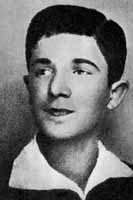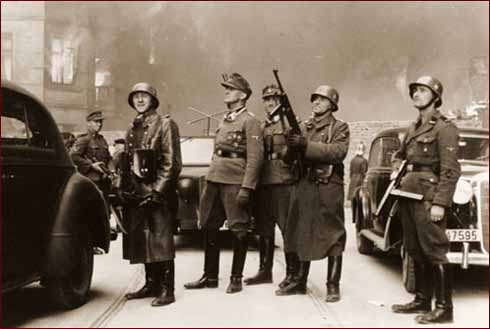Holocaust Resistance: The Warsaw Ghetto Uprising
(April 19 - May 16, 1943)
In 1942, Hitler decided to liquidate the ghettos and, within 18 months, had the more than two million Jews who’d survived the ghettos deported to death camps.
The Germans ordered the Jewish “police” in the Warsaw ghetto to round up people for deportation. Approximately 300,000 men, women, and children were packed in cattle cars and transported to the Treblinka death camp where they were murdered. This left a Jewish population of between 55,000 and 60,000 in the ghetto.
|
|
In April 1943, the Jews learned the Germans planned to deport all the people who remained in the Warsaw ghetto to Treblinka. A group of mostly young people formed an organization called the Z.O.B. (for the Polish name, Zydowska Organizacja Bojowa, which means Jewish Fighting Organization). The Z.O.B., led by 23-year-old Mordecai Anielewicz, issued a proclamation calling for the Jewish people to resist going to the railroad cars.
In January 1943, Warsaw ghetto fighters fired upon German troops as they tried to round up another group of ghetto inhabitants for deportation. Fighters used a small supply of weapons that had been smuggled into the ghetto. After a few days, the troops retreated. This small victory inspired the ghetto fighters to prepare for future resistance.
The impact on the ghetto residents is described in the Encyclopedia of the Holocaust:
After the January battle, the Jews spent the following weeks training, acquiring weapons, and making plans to defend of the ghetto. The Germans also prepared for the possibility of a fight. On the eve of the final deportation, Heinrich Himmler replaced the chief of the SS and police in the Warsaw district, Obergruppenfuhrer Ferdinand von Sammern-Frankenegg, with SS und Polizeifuhrer (SS and Police Leader) Jurgen Stroop, an officer who had experience fighting partisans.
|
|
The ghetto fighters were warned of the timing of the final deportation and the entire Jewish population went into hiding. On the morning of April 19, 1943, the Warsaw ghetto uprising began after German troops and police entered the ghetto to deport its surviving inhabitants. Seven hundred and fifty fighters armed with a handful of pistols, 17 rifles, and Molotov cocktails faced more than 2,000 heavily armed and well-trained German troops supported by tanks and flamethrowers..
After the Germans were forced to withdraw from the ghetto, they returned with more and more firepower. After several days without quelling the uprising, the German commander, General Jürgen Stroop, ordered the ghetto burned to the ground building by building. Still, the Jews held out against the overwhelming force for 27 days. On May 8, the headquarters bunker of the ZOB at 18 Mila Street was captured. Anielewicz and a large number of his colleagues were killed in the fighting, but several dozen fighters escaped through the sewers.
On May 16, Stroop announced the fighting was over. He said his forces had captured 56,065 Jews and announced that he was going to blow up the Great Synagogue on Tlomack Street (which was outside the ghetto) as a symbol of victory and of the fact that “the Jewish quarter of Warsaw no longer exists.”
Approximately 300 Germans and 7,000 Jews were killed in the uprising, and another 7,000 Jews were deported to Treblinka. The outcome was preordained, but the dramatic act of resistance helped raise the morale of Jews everywhere, if only briefly.
Sources: Mitchell G. Bard, The Complete Idiot’s Guide to World War II, 3rd Edition, NY: Alpha Books, 2010.
United States Holocaust Memorial Museum.
Israel Gutman, ed. Encyclopedia of the Holocaust. Vols. 1-4, NY: Macmillan, 1995.
USHMM Photo of Stroop.




